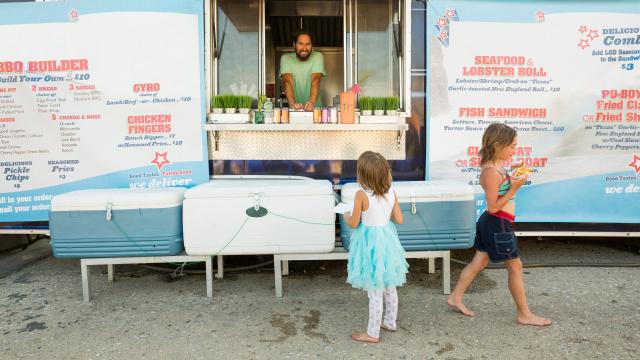Once, as a kid, I was at the food court at the shopping centre, and a mime was making balloon animals for all the children. He blew up a tube of latex, twisted it into a puppy, and handed it to me. I thanked him, and ran off to proudly show my mum and dad, who were sitting at a nearby table.
Photo: Ian Spanier (Getty Images)
“Look!” I said with glee.
The were disappointed. “Don’t talk to strangers,” they scolded.
As a shy and sensitive kid, I developed low-grade anxiety around strangers: I turned away from ladies at the market who complimented my dress, bank tellers who asked what my name was, and employees who handed out samples in front of restaurants. I don’t blame my parents for emphasising a “stranger danger” mentality – in the ’80s, television PSAs kept warning of creepers luring kids into cars. But now that I’m a mum, I see the same cautious tendencies in my five-year-old daughter, and while a lot of it is shyness, I worry. I want her to be safe, but I don’t want her to preemptively fear people.
In online parenting groups, I see the same plea come up often: “Help! My child strikes up conversations with every adult she sees at the playground. How can I teach her about stranger danger?” (The fear almost always surrounds girls rather than boys.) I say we don’t. While I understand the anxiety that fuels stranger danger, there are a few problems with the concept.
First, emphasising stranger danger overlooks a more pressing problem. While viscerally disturbing, child abduction by strangers is exceedingly rare. What’s true is that 90 per cent of the harm done to children is by people they already know.
“Telling kids not to talk to strangers fails to protect children at the most basic level,” writes early childhood expert Heather Shumaker in The Daily Beast. “Children are most often harmed by friends and family. This unsettling statistic is one we wish would go away. It’s far more convenient to blame the faceless stranger than to confront domestic violence, incest and other abuse.”
Second, it’s just confusing for kids. Who’s a stranger? The new Year One teacher? The nurse they just met? Should they fear everyone?
Finally, when you strip kids from interactions with new people, it prevents them from developing the critical, real-world skill of sensing potentially dangerous situations. And that’s something that takes practice.
In life, it is good to talk to strangers. People who talk to strangers – in coffee shops, in lines at the post office, while stretching before yoga class – are luckier and feel more connected to those around them. And kids, who are new to this world, can get a lot of early practise talking to strangers because almost everyone is a stranger. Here’s how to help keep your kids safe without mentioning stranger danger.
Let Them Trust That ‘Uh-Oh’ Feeling
You can and should explain to your kids that they may meet people who don’t want what’s best for them. Know that children naturally have good intuition. The Ruby’s Studio episode “The Safety Show” teaches young kids to recognise and trust their instincts when something doesn’t feel safe, describing that uneasiness as an “uh oh” feeling. Remind your children that if they ever get an “uh oh” feeling, they should tell a parent, teacher or other trusted grownup. Even if something feels mostly safe, they should check with an adult just in case.
Talk About ‘Tricky People’
There’s a movement to rebrand “strangers” as “tricky people”. Introduced by Safely Ever After, an educational company dedicated to preventing childhood sexual abuse, the idea is that it isn’t how well a child knows a person, it’s what they say or do that makes them “tricky”. A tricky person might tell a kid to keep a secret, or ask for help, or do something else that makes them feel uncomfortable.
Have Kids Practise Talking to Strangers in Your Presence
It not only helps them develop good social skills, but it gives them confidence in figuring out who they can trust.
[referenced url=”https://www.lifehacker.com.au/2018/03/let-your-kid-order-the-pizza/” thumb=”https://i.kinja-img.com/gawker-media/image/upload/t_ku-large/upaprvazyemiwdwchghv.jpg” title=”Let Your Kid Order The Pizza ” excerpt=”One afternoon, when my daughter was two, I picked her up from day care, and her teacher couldn’t wait to tell me the news.”]
At the library, have them ask the librarian where they can find books on Egypt. At a restaurant, have them order their own meal. At the dog park, see if they can find out what a dog’s name is. If your kid is more introverted, you can check in after the conversation, asking, “How did that feel?”
Most strangers are totally fine! Very helpful, even. Kids will need to talk to strangers throughout their lives. The sooner they feel comfortable with that, the sooner they will be able to trust themselves to know if something isn’t quite right.

Comments